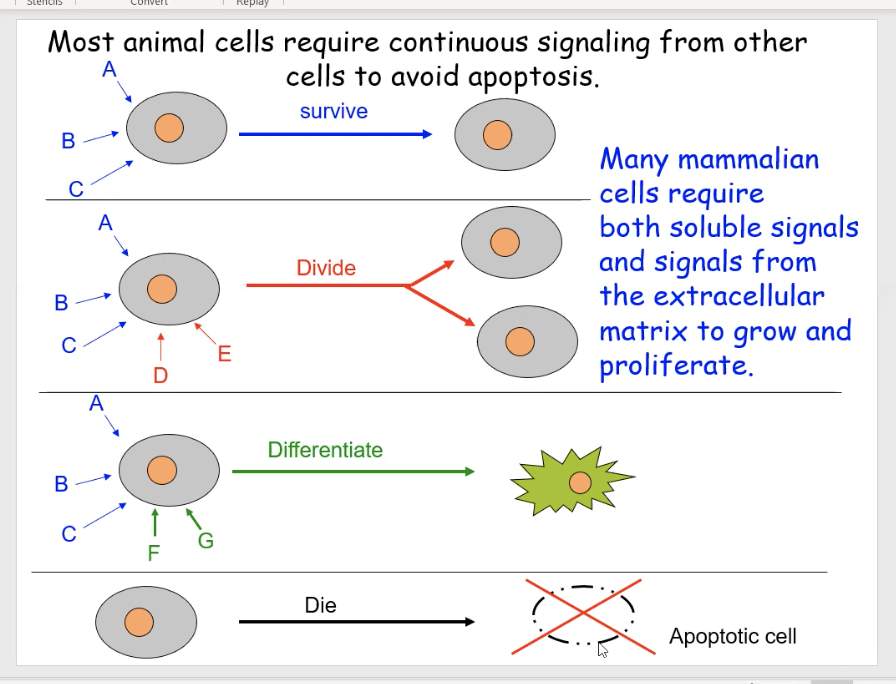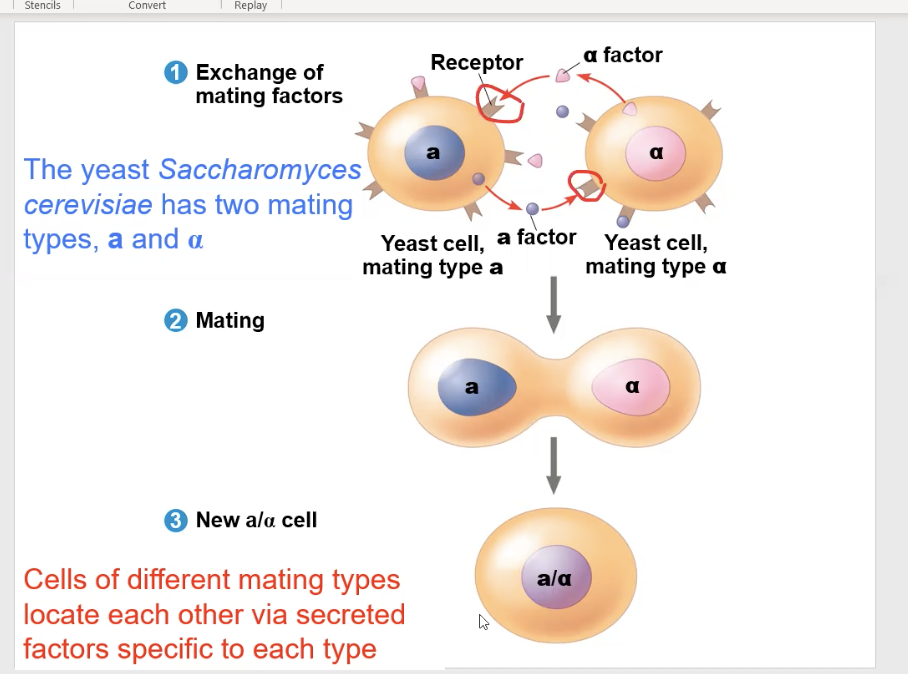Signal Transduction Ch. 11 videos 1&2
1/22
There's no tags or description
Looks like no tags are added yet.
Name | Mastery | Learn | Test | Matching | Spaced |
|---|
No study sessions yet.
23 Terms
Cell signaling (multicellular)
Cells require constant signaling from their environment, other cells, and their own interior
The diagram shows different examples of cells getting various combinations of signals, which enable them to perform specific functions.
Cell 1 is getting signals from signals A,B,C to tell it to survive
Cell 2 is getting signals from A, B, C AND D, E, which tells it to divide
Cell 3 is getting signals from A, B, C AND F, G telling it to mature
Cell 4 has no signals which means it should undergo apoptosis

unicellular cell communication
Single-celled organisms can communicate with each other
yeast cell communication
They communicate by secreting soluble factors on each other. also known as mating factors
The Saccharomyces cerevisiae yeast has two different factor types, the “a” type and the “α” type
The “a” type and “α” type yeast can only mate with each other, so they send each other the mating factors, and can only bind to each other’s receptors

Quorum sensing
Prokaryotes, single-celled organisms, can use this to cell signal
a form of bacterial communication where cells release signal molecules to sense their population density
local signaling
whens cells communicate with nearby cells, or with cells in direct contact with them.
Direct contact local signaling
Gap junctions in animal cells, plasmodesmata in plant cells, and Transmembrane proteins for cell-to-cell recognition all allow for direct local signaling
Plasmodesmata
channels in land plant and algal cell walls that connect the cytoplasm of neighboring cells, allowing for direct transport and communication of molecules like sugars, ions, proteins, and RNA
gap junctions
Protein channels in animal cells that connect the cytoplasm of adjacent cells, allowing direct passage of ions, small metabolites, and signaling molecules without entering the extracellular space
cell-to-cell interactions: Transmembrane proteins
Many transmembrane proteins function as gateways to permit the transport of specific substances across the membrane
Non direct contact local signaling
paracrine signaling and Autocrine signaling
paracrine signaling
Animal cells may use secreted messenger molecules (molecules travel short distances) to communicate with the target cell
The target cell must have a specific receptor for that messenger molecule
synaptic signaling
a specific type of paracrine signaling. An axon will extend to target cell, and release neurotransmitters.
Autocrine signaling
the secreting cell will send a signal, and it binds back on itself on its own receptor
long distance signaling
endocrine signaling
endocrine signaling
the secreting cell will send signals into the blood stream and travel down the blood vessel to the target cell
signaling molecules
can be either polar or nonpolar.
Nonpolar molecules easily travel through the plasma membrane. The signal molecule will enter the target cell and bind to a receptor inside the target cell. when the receptor binds to the signal, the receptor will go through a. conformational change (steroids are generally non-polar, e.g., cortisol)
polar signal molecules will find their receptor embedded in the plasma membrane (polypeptides and amino acids generally polar, e.g., secretin and epinephrine, respectively)
ligand
signal molecule
4 main types of receptors
Intracellular receptors
ion channel receptors
G-protein-linked receptor
Protein kinase (enzyme-linked) receptors
Intracellular receptors
located in the cytoplasm and nucleus
binds to nonpolar signal molecules
is often a transcription factor (After the ligand binds to the receptor, the receptor will go through a conformational change, which allows the ligand+receptor unit to change location, into the nucleus to aid in transcription)
Ion channel receptors
transmembrane receptor
When a ligand binds to the receptor, a conformational change causes the channel's "gate" to open, allowing specific ions (like Na⁺, K⁺, Ca²⁺, or Cl⁻) to flow across the cell membrane
“ligand-gated ion channel” (the presence of a ligand determines if the channel is open or closed)
Neuron signaling is an example
G- protein linked receptor
a receptor bound to a G protein
Protein kinase receptors
kinase is an an enzyme that puts a phosphate group on something
Upon binding to a ligand, the kinase receptor will transport phosphate groups to proteins
signal transduction pathway
an external signal, such as a hormone or neurotransmitter, triggering a series of molecular events, that forms the cells response to the signal.
basically a ligand binds to surface receptor→intracellular events occurs→these events trigger the the cellular response